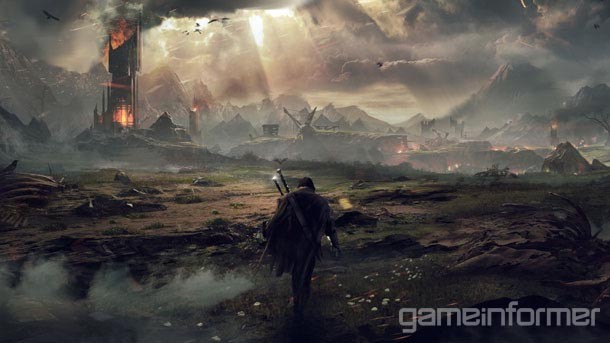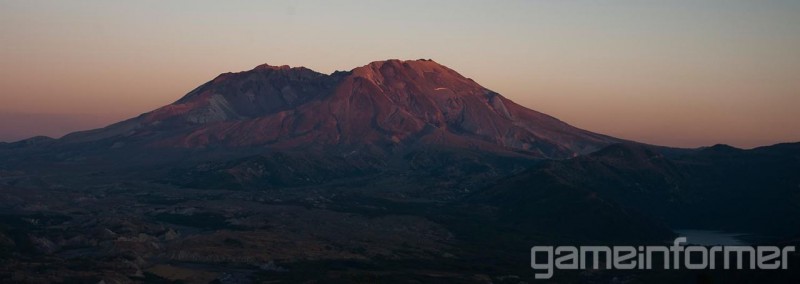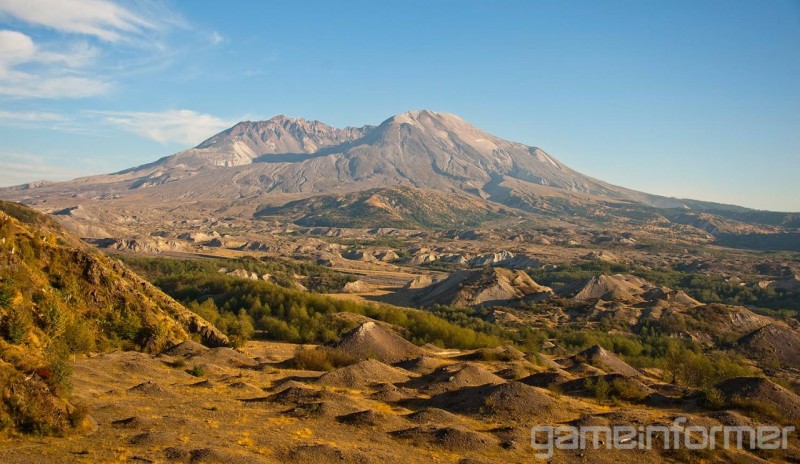Crafting The Black Lands: The Art Of Shadow Of Mordor

In The Lord of the Rings trilogy, Mordor is a land so corrupt with evil that few even dare speak its name. The Dark Lord Sauron dwells behind its Black Gates, building up power to conquer Middle-earth. The Mordor we revealed in our cover story of Monolith Production’s Middle-earth: Shadow of Mordor isn’t quite as far gone as the tainted land we’ve come to know. Mount Doom towers above quietly, scant greenery covers some areas, and hardy humans have tried to carve out a life there. Sauron’s orcs and other wretched creatures are just beginning their domination of Mordor at the beginning of the game. We spoke with Monolith about crafting this earlier version of the iconic hellscape.
Art director Phil Straub is a key Monolith developer shaping the slightly fresher look of Mordor. We asked whether Middle-earth: Shadow of Mordor draws its core visual inspiration from descriptions in Tolkien’s book, Peter Jackson’s films, or elsewhere.
“As a team, we have looked at as many references as we can, relative to the IP,” Straub says. “Of course, we looked at the films. But I think that my approach and my thought on this is the main thing we want this game to have – which I think the Lord of the Rings films have – is authenticity. When I talk about that, what that means is all the way down to the costuming, all the way down to the geography, all the way down to the weather and the evolution of the creatures. So where I see us fitting is a heightened realism or gritty realism. So we are definitely more in the continuum of a very realistic presentation and I think that the next gen hardware allows for that as well.”

A reference photo from Central Washington, courtesy of Monolith Productions
A core inspiration for Monolith’s gritty realism comes from being based in Kirkland, Washington. Mount Rainier and Mount St. Helens are located south of Seattle, standing 12,411 feet and 8,365 feet, respectively. The latter erupted in 1980 in what was the most disastrous volcanic eruption in U.S. history.
“We live in the blast radius of a huge apocalyptic volcano,” says Michael dePlatter, director of design for Shadow of Mordor. Mount Rainier, Mount St. Helens, and the volcanic landscape around them have become invaluable research material for Monolith.
“There is an area in eastern Washington that was flooded a number of million years ago relative to the volcanic activity,” Straub says. “It’s actually really interesting, because everything down to the types of rock that are in the game, those are accurate to the geology that likely would have been in Mordor because of the volcanic activity and the evolution of those geological elements over time.

A reference photo from Mount St. Helens, courtesy of Monolith Productions
“It was a great opportunity, because we have so much of that right at our back door that we can actually go and do location shoots. Speaking with the art team responsible for creating the world, I specifically defined, ‘OK, this is the geological evolution that we’re focused on. These are the type of rocks that you would see. So this is a basalt-type rock.’ Even down to the shrubs, even down to the grass. These are the types of shrubbery and grass that would grow in this type of geology and which maps to Mordor.”
Some may find it difficult to imagine anything green growing on the hellish terrain of Mordor or the exterior of Mount Doom. But don’t expect Monolith to go so far as to populate the land with dense jungle.
“Sauron hasn’t been around for a long, long time,” Straub says. “If you think of an area that’s been burned out over and over and over again, if you think about all the fires that happen here on the West coast, that has an impact on the geology over and over and over again. It changes the evolution of the creatures there. It is an area that has gone through a lot of war and a lot of geological activity, but it has come back. We are seeing some foliage, but we didn’t want to go full on lush because I personally felt like that was going too far.”

This photo from Monolith offers a closer look at the terrain around Mount St. Helens
Washington proved useful for designing Mordor’s volcanic landscape, but Monolith didn’t just limit scouting trips to its home state. Straub also notes Yellowstone National Park and locations in Iceland as inspirations. Monolith is also in cooperation with Peter Jackson, Middle-earth Enterprises, and Weta Digital’s team of special-effects wizards.
We asked Straub about the variety players might expect to see when adventuring in Mordor. Landmarks like the Black Gates, the tower of Barad-dûr, and Mount Doom are givens, but he hints at other ways Monolith will be injecting environmental variety.
“I’m all about very dramatic lighting, and weather is a huge thing for us too,” Straub says. “So in the game, we have multiple locations that you can go to but even within those locations, we have a large variety of how we present the atmosphere in those locations, how we present the weather, and how we present the nasty environment that is Mordor.”

Looking at concept art for Shadow of Mordor (above) shows the proof of Straub’s statement. At a glance the scene above might appear to be set on an ominous night, but the god rays struggling to break through above remind us even the sun can’t easily enter Mordor.
Crafting a new look for a land as nefarious as Mordor is no small undertaking. Thankfully for gamers and Tolkien fans alike, Monolith is diving deep into both Middle-earth’s lore and realistic volcanic terrain to craft Shadow of Mordor. Wherever this quest leads us, Monolith’s unique vision of Sauron’s Black Lands is sure to simultaneous impress and oppress when it hits current- and next-gen systems.
Be sure to take a closer look at the stunning concept art and reference photos in the media gallery below.
To learn more about Middle-earth: Shadow of Mordor, stay tuned to our exclusive coverage hub by click on the banner below.
To stay up to the minute with our Shadow of Mordor updates, follow Game Informer on Twitter, Google+, and Facebook. And, to keep up to date with Shadow of Mordor's official feeds, check the game's official site, Facebook, or Twitter.

Get the Game Informer Print Edition!
Explore your favorite games in premium print format, delivered to your door.
- 10 issues per year
- Only $4.80 per issue
- Full digital magazine archive access
- Since 1991










